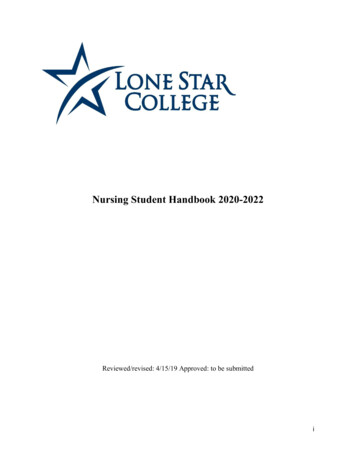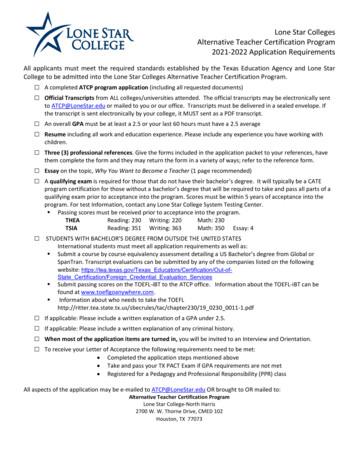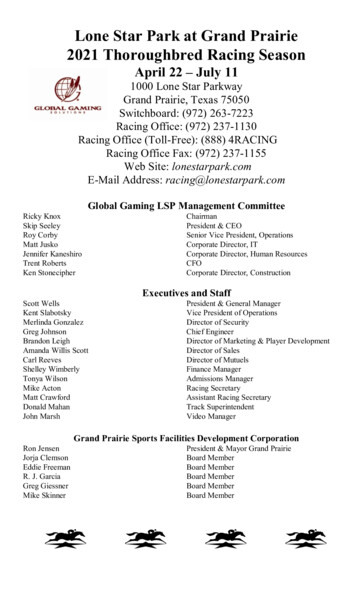
Transcription
Lone Star College
Successful colleges and universities understand the importance ofretaining students and helping them achieve their academic goals,particularly as retention rates drop to around 40 percent at many U.S.institutions. While students attend college for cultural and intellectualenrichment, they also expect to see a direct monetary return on theireducational investments, as measured by better job opportunities,sustainable careers, and higher salaries. As Lone Star College (LSC) haslearned, ensuring positive student outcomes and maintaining positiveenrollment trends requires a new advisement strategy, backed by modernsoftware applications that automate student advisement, class selection,and curriculum maps.THE PERENNIAL OBJECTIVE: STUDENT SUCCESSLone Star College offers high-quality, low-cost academic transfer and career training education to99,000 students each semester. As the largest institution of higher education in the Houston, Texasarea, with an annual economic impact of nearly 3 billion, LSC consists of sevencolleges, eight centers, two university centers, Lone Star Corporate College, and LSC-Online.Like many institutions of higher education, Lone Star College works diligently to increase studentretention, increase graduation rates, and support students in their efforts to complete their studies,earn degrees, and prepare for the workforce. Lone Star must also comply with state funding efforts,such as a statewide master plan for higher education known as Closing the Gaps. Established by theTexas Higher Education Coordinating Board, Closing the Gaps includes an outcomes-based fundingcomponent in which colleges are awarded for academic progression milestones, such as total numberof degrees awarded, number of degrees earned in critical fields, and the proportion of “at-risk”students within the college population.In addition to complying with this statewide mandate, LSC saw Closing the Gaps as an opportunity tofocus on making students more successful by helping them achieve their academic goals. Previously,the institution favored a broad, open advising module. The emphasis was on giving students unbridledfreedom for selecting classes, completing studies, and obtaining degrees. Led by Stephen C. Head,Ph.D., chancellor of LSC, Lone Star’s faculty and staff embraced a more structured advisement model,as successfully promulgated by many European colleges. Once students have identified a major, theyare offered explicit guidance about which courses they should take, with the objective of helping themcomplete their studies in the prescribed amount of time. Rather than haphazardly selecting electiveclasses from dozens of choices, they are encouraged to focus on courses that help them complete therequirements for a particular major, so they can move more quickly towards graduation, and succeedwith their post-academic endeavors.“With an increased focus on graduation rates and the necessity to comply with state funding programs,our goal is on making sure students don’t accumulate unnecessary credit hours and courses duringtheir college careers,” says Longin Gogu, Associate Vice Chancellor of Enterprise Applications, Officeof Technology Services, LSC. “Our advisement model helps students stay focused on the end goal.”2CUSTO MER SUCCESS STORY / Lone Star CollegeTo remain competitive with othercollege institutions and continuallyrelevant to students, today’sinstitutions of higher educationmust intelligently optimize theiroperations, boost their institutionalstandings, and improve studentoutcomes.“Student success is first andforemost our priority from aleadership perspective at LoneStar College. One of theprograms I am most excited aboutis our Guided Programs of Studyproject, laddering nicely to LoneStar’s core mission of studentsuccess. By connecting the dotsfrom academic planning totechnology, this project will helpour students stay on track andgraduate in a timely manner.”Link AlanderVice Chancellor of CollegeServices and CIO,Lone Star College
INTRODUCING THE GUIDED PROGRAMS OF STUDY PROJECTSo began a two-year effort to redesign LSC’s curriculum and to guide students on paths that maximizetheir success. Many faculty and staff members participated in this endeavor, which yielded newpathways, standards, and academic structures. “This was not just an effort to look at pre-requisites,but to create structured pathways and program maps,” Gogu adds.Once the basic guidelines were in place, Gogu and other stakeholders shifted their attention toacquiring a technology platform that could manage student data related to advisement, class selection,and curriculum maps. They wanted a system that was easy to use and that could help LSC addressstate funding requirements. “A complex curriculum pathway must meet the goals of students,” Gogusays. “Signing up for classes should be easy and intuitive.”LSC evaluated several different software applications that could potentially help with this effort. “Thereare a few products on the market that focus on pathways and degree planning topics, which arerelated to the challenges LCS was facing,” Gogu recalls. “A big factor involved integration with ourStudent Information System.”In short, LSC wanted a technology platform that could support real-time synchronization of studentdata among the college’s critical information systems. For example, instead of periodically transferringflat files in batch mode, which introduces time delays, they wanted a system that could perform realtime updates as transactions occur and student data changes. In addition, Gogu and his team insistedon a solution that could provide a consumer-like experience for faculty, staff, and students.“The higher education industry isexperiencing a period of historicdisruption, driving colleges anduniversities to consider newoperating models, seek outinnovative ways to engagestudents, and deliver targetededucation services. Studentinformation systems have apivotal role to play in whether ornot institutions are successful inthese endeavors, but establishedapproaches and many existingsolutions may prove insufficient tomeet the rising expectations ofstudents for more personalized,frictionless, and proactiveservices.”Ovum 1“We recognized early on that integration with our core student information system would beparamount,” Gogu says. “Today’s users expect instant responses, just like they obtain with an Amazonshopping experience. Because we have a large student population, we cannot afford a 12-hour or 24 hour delay for updating advisement data. When students enroll in classes, those events must bereflected immediately in the curriculum maps and degree plans, so all students can make informedchoices.”In other words, changes in the student information system must trigger similar updates to studentrecords and enrollment records, so the advisement content is always current. These real-time updatesensure that students are fully informed about available enrollment options. For example, if a student’sdegree audit report or advisement report tells her that she needs a certain math class, the data will betransferred from the advisement solution to the enrollment solution—allowing her to see right awaywhether the class is available.“Real-time integration is critical, and all changes must be instantly reflected,” Gogu reiterates. “If thereis a delay, a student might not know that a class is full. Delays create unnecessary barriers that couldlead to lower enrollment. The easier we can make it for the students, the better we can help themachieve success.”AN INTEGRATED SOLUTION THAT PRESERVES EXISTING INVESTMENTSAfter evaluating several potential technology solutions, Gogu and other LSC stakeholders determinedthat the Program Enrollment module within Oracle PeopleSoft Campus Solution was best suited tohelping them achieve their goals for advising and guiding students. LSC already uses the PeopleSoftstudent information system, part of the Oracle PeopleSoft application portfolio, which would simplifythe integration process. To spearhead the initiative, LSC retained a European consulting firm that hadexperience with structured program enrollment models. This firm helped LSC configure an extensiblesystem and develop a Fluid mobile front-end that ensures an engaging student experience.LSC’s PeopleSoft Program Enrollment module is now entering production mode. Incoming studentsenrolling in Spring 2020 classes will utilize the new system. In successive semesters, existing and3CUSTO MER SUCCESS STORY / Lone Star CollegeOracle Solutions for Higher EdBuilt natively for the cloud tosupport the entire institution andstudent lifecycle, Oracle HigherEducation solutions include: Student Cloud Enterprise Resource Planning(ERP) Enterprise PerformanceManagement (EPM) Human Capital Management(HCM)All modules work together as partof a shared cloud platform.
continuing students will rely on the PeopleSoft system to ease the transition from a traditional to amore structured advisement model.HIGHER EDUCATION SOLUTIONS FROM ORACLEWhile Lone Star College is leveraging the capabilities of Oracle’s Campus Solutions product, they arealso actively involved in the development and design of Oracle’s next-generation student informationsystem, Oracle Student Cloud, which is natively built in the cloud. Oracle offers a comprehensiveapproach to managing the student lifecycle, communications, and relationships—from recruitingthrough alumni and donor management. By more effectively engaging students, Oracle Student Cloudhelps colleges and universities improve student outcomes, raise institutional standing, and increaseoperational efficiency with intelligent automation.Oracle’s next-generation Student Cloud includes six interconnected modules: Student Financial PlanningStudent ManagementStudent RecruitingStudent EngagementStudent SupportAdvancementEach module works with the others and shares pertinent data to streamline essential activities. Fromattracting students and assigning courses to managing student accounts and providing easy paymentprocessing during the enrollment process, these applications provide all the tools colleges need to runefficient operations geared for student success.Oracle offers a practical path to the cloud, with a range of choices to help you get started right away.You can deploy cloud services incrementally on Oracle’s robust public cloud and gradually build aunified higher education platform that encompasses all these functions.To learn how you can launch your own cloud SIS initiative, visit d.html.14“Intelligence Will Transform Student Information Systems” (30 October 2017)CUSTO MER SUCCESS STORY / Lone Star CollegeGuided Pathways for StudentsOracle Student Management, partof Oracle Student Cloud, keepsadvisors informed so they canhelp students make the rightacademic choices. Establishguided pathways that allowstudents to enroll in courses andtrack their academic progress.Oracle Solutions for StudentSuccess COMPLETE to gain efficiencyfrom one single data model INTELLIGENT to driveinnovation and fast decisions ADAPTABLE to meet eachinstitution’s specific needs
ORACLE CORPORATIONWorldwide Headquarters500 Oracle Parkway, Redwood Shores, CA 94065 USAWorldwide InquiriesTELE 1.650.506.7000FAX 1.650.506.7200oracle.com 1.800.ORACLE1CONNECT W ITH USCall 1.800.ORACLE1 or visit oracle.com. Outside North America, find your local officeat .com/oracletwitter.com/oracleCopyright 2019, Oracle and/or its affiliates. All rights reserved. This document is provided for information purposes only, and the contents hereof aresubject to change without notice. This document is not warranted to be error-free, nor subject to any other warranties or conditions, whether expressedorally or implied in law, including implied warranties and conditions of merchantability or fitness for a particular purpose. We specifically disclaim anyliability with respect to this document, and no contractual obligations are formed either directly or indirectly by this document. This document may not bereproduced or transmitted in any form or by any means, electronic or mechanical, for any purpose, without our prior written permission.Oracle and Java are registered trademarks of Oracle and/or its affiliates. Other names may be trademarks of their respective owners.Intel and Intel Xeon are trademarks or registered trademarks of Intel Corporation. All SPARC trademarks are used under license and are trademarks orregistered trademarks of SPARC International, Inc. AMD, Opteron, the AMD logo, and the AMD Opteron logo are trademarks or registered trademarksof Advanced Micro Devices. UNIX is a registered trademark of The Open Group. 1019
leadership perspective at Lone Star College. One of the programs I am most excited about is our Guided Programs of Study project, laddering nicely to Lone 's core mission of student success. By connecting the dots from academic planning to technology, this project will help our students stay on track and graduate in a timely manner."










